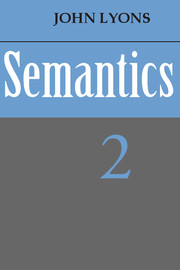Book contents
- Frontmatter
- Contents
- Figures
- Typographical conventions
- Preface
- 10 Semantics and grammar I
- 11 Semantics and grammar II
- 12 Semantics and grammar III
- 13 The Lexicon
- 14 Context, style and culture
- 15 Deixis, space and time
- 16 Mood and illocutionary force
- 17 Modality
- Bibliography
- Index of subjects
- Index of personal names
15 - Deixis, space and time
Published online by Cambridge University Press: 05 June 2012
- Frontmatter
- Contents
- Figures
- Typographical conventions
- Preface
- 10 Semantics and grammar I
- 11 Semantics and grammar II
- 12 Semantics and grammar III
- 13 The Lexicon
- 14 Context, style and culture
- 15 Deixis, space and time
- 16 Mood and illocutionary force
- 17 Modality
- Bibliography
- Index of subjects
- Index of personal names
Summary
Person-deixis
The term ‘deixis’ (which comes from a Greek word meaning “pointing” or “indicating”) is now used in linguistics to refer to the function of personal and demonstrative pronouns, of tense and of a variety of other grammatical and lexical features which relate utterances to the spatiotemporal co-ordinates of the act of utterance. As employed by the Greek grammarians, the adjective deictic (‘deiktikos’) had the sense of “demonstrative”, the Latin ‘demonstrativus’ being the term chosen by the Roman grammarians to translate ‘deiktikos’ in the works of the Stoics, of Dionysius Thrax and of Apollonius Dyscolus, which laid the foundations of traditional grammar in the Western world. It is worth noting that what we now call demonstrative pronouns were referred to as deictic articles in the earlier Greek tradition and that the Greek word ‘arthron’, from whose Latin translation, ‘articulus’, the technical term article derives, was no more than the ordinary word for a link or joint. It was only in the later tradition that the Greek equivalent of ‘pronoun’ was used; and this fact is of some significance. The point is that in early Greek, no sharp distinction can be drawn, in terms of their forms or syntactic and semantic function, between demonstrative pronouns, the definite article and the relative pronoun: the term ‘article’ was at first applied to them all, and it was chosen, presumably, because they were regarded as connectives of various kinds.
- Type
- Chapter
- Information
- Semantics , pp. 636 - 724Publisher: Cambridge University PressPrint publication year: 1977
- 19
- Cited by

